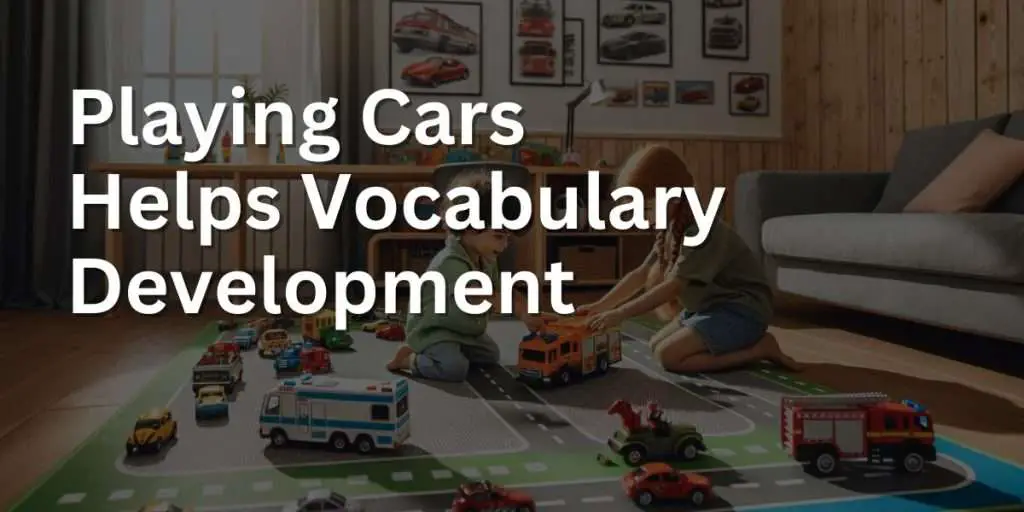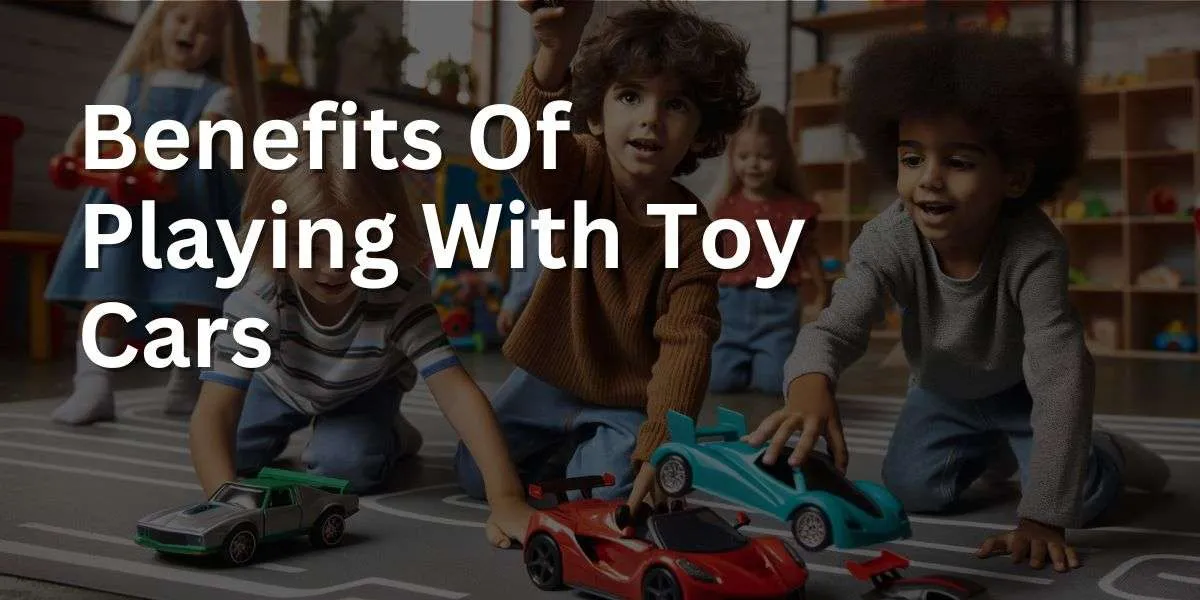Diving into the Benefits Of Playing With Toy Cars unveils more than just the thrill of speed and adventure. Beyond the vroom and zoom, toy cars play an instrumental role in a child’s cognitive, motor, and social development.
Toy cars, with their diverse designs and functionalities, encourage imaginative play, problem-solving, and hand-eye coordination. Whether navigating a track, learning about different car models, or engaging in group play, these toys foster skills that extend beyond the playroom. This guide will delve into the multifaceted advantages of playing with toy cars, showcasing how they contribute to various developmental milestones.
Eager to understand the full spectrum of benefits toy cars bring to the table? Accelerate with us as we journey through the enriching world of toy car play.
Playing with toy cars offers numerous benefits for toddlers, aiding in their holistic development. Firstly, it enhances their fine motor skills as they grasp, push, or pull these vehicles. This repetitive motion strengthens hand-eye coordination and paves the way for tasks like writing in the future. Toy cars also foster creativity and imagination. When a child zooms a car around, creates traffic jams, or enacts races, they’re crafting narratives and scenarios, stimulating their imaginative play.
These cars also introduce basic concepts of physics, such as motion, speed, and gravity, as toddlers observe how cars move on different surfaces or slopes. Socially, when played in groups, toy cars teach sharing, negotiation, and turn-taking, essential skills for their age. Moreover, recognizing different types and colors of cars can enhance a toddler’s cognitive development and vocabulary. Toy cars, though simple, provide a multi-faceted platform for learning and development for toddlers.
Key Takeaways on Benefits of Car Play in Early Childhood
| Benefit | Description |
|---|---|
| Car Play Improves Motor Skills | Pushing, pulling, and rolling toy cars helps in the development of fine and gross motor skills. |
| Playing Cars Helps Imagination & Creativity | Kids often create scenarios, races, and adventures for their toy cars, promoting imaginative play. |
| Car Play Improves Spatial Awareness | Navigating toy cars around obstacles or along tracks can enhance a child’s understanding of space and dimensions. |
| Playing Cars Helps Problem Solving | Setting up tracks or figuring out how to maneuver cars in certain situations can cultivate problem-solving skills. |
| Car Play Improves Hand-Eye Coordination | Playing with toy cars can improve coordination as children learn to move and control them with precision. |
| Playing Cars Helps Social Skills | When played in groups, children learn to share, negotiate routes, and communicate with peers. |
| Car Play Improves Understanding Cause and Effect | Observing the effects of pushing a car harder, or seeing how different surfaces affect movement, can teach kids about cause and effect. |
| Playing Cars Helps Vocabulary Development | Discussing colors, sizes, and actions related to toy cars can enhance vocabulary. |
| Car Play Improves Cognitive Development | Setting up intricate tracks or routes requires planning and foresight, which can promote cognitive growth. |
| Playing Cars Helps Sensory Play | Toy cars can be tactile, and playing with them can stimulate various senses. |
Car Play Improves Motor Skills
Car play is instrumental in enhancing a child’s motor skills as it merges physical activity with cognitive engagement. Small hands grasping, twisting, and turning toy vehicles translate into fine motor skill advancement, while broader movements like reaching and scooting bolster gross motor development.
As children navigate toy cars through imagined landscapes, they’re not just having fun; they’re also honing hand-eye coordination and dexterity, essential components of their physical growth and development.
Playing Cars Helps Imagination & Creativity
Playing with the best toy cars offers a roadway to imagination and creativity, as children craft stories and scenarios that transcend the here and now. With each roll, twist, and turn of their toy vehicles, they’re not merely playing; they are directors of their own adventures, fostering narrative skills and inventive thought.
This form of play is a canvas for expression, where each car becomes a character, and every race, a tale, cultivating a rich imagination that fuels both creative thinking and problem-solving abilities.
Car Play Improves Spatial Awareness
Car play enhances spatial awareness as children navigate the miniature vehicles through the space around them. They learn to judge distances, understand the concept of speed, and grasp the intricacies of spatial relationships, all through the dynamic act of play.
This engagement not only entertains but also serves as a fundamental exercise in developing their ability to assess and interact with the physical world, laying the groundwork for future spatial reasoning skills.
Playing Cars Helps Problem Solving
Playing with cars enhances problem-solving skills as children navigate obstacles and create strategies for play scenarios. Imaginative play with vehicles encourages spatial awareness and critical thinking as young minds decide on routes and overcome barriers. Interactions with others during car play often require negotiation and collaboration, further honing their problem-solving abilities.
Toy cars serve as tools for experimentation, with kids testing theories on motion and speed, which teaches cause and effect. Building tracks and complex car layouts promotes engineering thinking, as young builders assess stability and functionality. Solo and group play with cars provide rich opportunities for children to challenge themselves and develop resilience.
Engagement in car play is joyful, yet packed with learning potential, supporting cognitive development in a fun, hands-on way. These play experiences are crucial in early childhood, laying the groundwork for future academic and personal problem-solving scenarios.
Car Play Improves Hand-Eye Coordination
Car play significantly improves hand-eye coordination as children steer their toy vehicles, aligning their visual perception with the precise movements of their hands. This playful activity demands the synchronization of sensory information and motor skills, contributing to the delicate tuning of their developmental abilities.
Through the simple joy of guiding cars along imagined roads, children enhance their coordination, a skill that proves essential in many facets of daily life and further learning.
Playing Cars Helps Social Skills
Playing with cars fosters social skills as children engage in shared play, negotiate roles, and develop communication. These interactions often involve turn-taking and understanding perspectives, essential components of social development. The cooperative nature of car play, where children organize races or traffic scenarios, encourages empathy and teamwork.
Through this play, children also learn to articulate their thoughts and listen to others, forming the foundation for strong interpersonal skills. In the realm of social development, understanding cause and effect through car play helps young ones make connections between their own actions and reactions from peers, an essential skill for social interaction. These playful activities are not only enjoyable but also instrumental in developing a child’s cognitive abilities.
Car Play Improves Understanding Cause and Effect
Car play improves understanding of cause and effect as children observe the relationship between actions and outcomes. Manipulating toy vehicles leads to immediate physical reactions, helping young learners grasp basic physics principles. Pushing a car harder results in faster motion, a clear demonstration of force and momentum.
Experimentation with different surfaces teaches kids about friction and resistance, while ramps and inclines introduce concepts of gravity and acceleration. Interactive playtimes with cars also encourage predictive thinking, as children anticipate the movement based on their actions. Engaging with toy vehicles thus lays a foundation for scientific inquiry and analytical thought.

Playing Cars Helps Vocabulary Development
Playing with cars enriches vocabulary development as children name parts, actions, and aspects of their play, creating a rich linguistic environment. This interaction with varied terms and phrases, often shared in social settings, fosters language acquisition and encourages communicative competence.
As children articulate experiences, negotiate roles, and describe their automotive adventures, they naturally expand their lexicon, laying the groundwork for effective communication and literacy skills.
Car Play Improves Cognitive Development
Car play enhances cognitive development as children engage in imaginative scenarios. Creating road maps and navigating toy vehicles through them fosters spatial awareness and planning skills. Organizing cars by attributes such as color or size promotes categorization and sorting abilities, essential cognitive skills.
Role-playing with cars allows children to explore different perspectives, enhancing empathy and social cognition. Sequencing play actions, like a car wash or race, bolsters understanding of temporal concepts and order of events. Memory is also exercised as children remember specific features or functions of various toy cars.
Engaging in car play with others requires communication and negotiation, sharpening language skills and cooperative play dynamics. Through these interactions, children learn to articulate thoughts and understand others’ viewpoints, a key aspect of cognitive development. Car play is a dynamic way to nurture a child’s cognitive growth in a joyful and interactive manner.
Playing Cars Helps Sensory Play
Playing with cars enhances sensory play, engaging children in a tactile experience as they touch, move, and interact with different textures and functions. This form of play stimulates the senses, as the child navigates through various sensory inputs, from the smooth contours of a car to the vibrations it may produce, fostering sensory integration and processing skills essential for development.
Through sensory play with cars, children gain a deeper understanding of their sensory preferences and boundaries, which is a foundational aspect of self-regulation and cognitive growth.
Frequently Asked Questions About Benefits of Toy cars and trucks
What skills can children learn from playing with toy cars?
Playing with toy cars can help children develop a variety of skills. For example, they can learn about cause and effect, as they push the cars and watch them move. They can also learn about spatial awareness, as they navigate the cars around obstacles and through different environments. Additionally, playing with toy cars can help children develop their fine motor skills, as they manipulate the cars with their hands.
How can toy cars help with a child’s hand-eye coordination?
Playing with toy cars can help children develop their hand-eye coordination in a number of ways. For example, they can practice picking up and moving the cars, which requires them to coordinate their hand movements with what they see. They can also practice fitting the cars into different slots or containers, which requires them to use their hand-eye coordination to make sure the cars are lined up correctly.
What are some creative ways to incorporate learning into toy car play?
There are many ways to incorporate learning into toy car play. For example, you can use different colored cars to teach children about colors. You can also use different types of cars to teach children about different modes of transportation, such as police cars, fire trucks, and ambulances. You can also use toy cars to teach children about cause and effect, such as by setting up ramps or obstacles for the cars to navigate.
How does playing with toy cars promote imaginative play?
Playing with toy cars can promote imaginative play by providing children with a way to create their own stories and scenarios. For example, they can pretend that the cars are going on a road trip, racing each other, or going on a rescue mission. By using their imaginations, children can develop their creativity and problem-solving skills.
Playing with toy cars can have social benefits as well. For example, children can play with toy cars together and learn to take turns, share, and communicate with each other. They can also develop their social skills by pretending to be different characters or by working together to solve problems.
Can playing with toy cars help with a child’s language development?
Playing with toy cars can help children develop their language skills in a number of ways. For example, they can practice using new vocabulary words to describe the cars and their actions. They can also practice using language to communicate with others during play, such as by asking for a turn or describing what they are doing.




